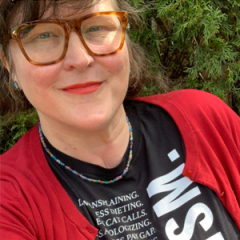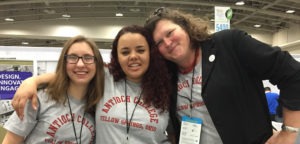Staff Directory

Kim Landsbergen
Associate Professor of Biology and Environmental Science

Antioch students Rian Lawrence (’17), Maya Canaztuj (’17), and Prof. Kim Landsbergen presented USEPA-funded P3 research at the National Science Fair in Washington D.C. April 2016.
Dr. Kim Landsbergen, Associate Professor of Biology and Environmental Science, is a Certified Senior Ecologist, specializing in invasive plant biology, climate change impacts on forests, soil carbon dynamics, urban ecosystems and ArtScience collaborations. She teaches a range of courses such as: Botany, Intro to Environmental Science, Ecology, Climate Change, Soils, Ecological Agriculture, Ecosystem Ecology, Trees, and more. In 2017, Kim was awarded the Excellence in Teaching Award from the Southeastern Ohio Council for Higher Education. She is active in developing environmental policy solutions in Ohio: her public service includes Board service on the Buckeye Environmental Network, Franklin County Soil Water Conservation District, and the Upper Arlington Ohio Tree Commission. Kim holds a courtesy research appointment in the Evolution, Ecology and Organismal Biology Department at The Ohio State University. She is a STARS Advisory Council member with the Association for Advancement of Sustainability in Higher Education (AASHE), and is active in campus sustainability efforts. She has published more than 25 peer-reviewed science articles and received numerous local, state and federal research grants to support projects at Antioch College.
Instagram/Twitter: treebiology
http://kimlandsbergen.com
Dr. Landsbergen on Google Scholar
Collaborative / Student Projects on Antioch Farm, Campus, and Glen Helen Nature Preserve
Education
- Postdoctoral Fellow, Lamont-Doherty Earth Observatory, Columbia University
- Ph.D., Forest Ecosystem Analysis, University of Washington, College of Forestry
- M.S., Forestry and Environmental Studies, Duke University, School of the Environment
- B.S., Chemistry and Biology (double major), University of Memphis
Scholarly Activities
Selected Publications
(Brown = maiden name for Kim Landsbergen. ‘*’ indicates student senior authorship of collaborative work with a undergraduate, graduate student or post-doc supervised by Dr. Landsbergen)
-
A. Ellison, C. LeRoy, K.J. Landsbergen, E. Bosanquet et.al., (2018) Art/Science Collaborations: New Explorations of Ecological Systems, Values, and their Feedbacks April 2018 in the Bulletin of the Ecological Society of America, https://doi.org/10.
1002/bes2.1384 -
D. Lieurance * and K.J. Landsbergen(2016) Plant biomass allocation and growth analysis of the invasive shrub Amur honeysuckle in varying light habitats. Journal of the Torrey Botanical Society. 143(4):415-426.
- J. Chiang * and K.J. Brown (2010) The effects of thinning and burning treatments on within-canopy variation of leaf traits in hardwood forests of southern Ohio. Forest Ecology and Management 260: 1065-1075
- H. Joesting *, B.C. McCarthy, and K.J. Brown (2009) Determining the shade tolerance of American chestnut using morphological and physiological leaf parameters. Forest Ecology and Management 257: 280-286
- R. Giuliani* and K.J. Brown (2008) Within-canopy sampling of global irradiance to describe downwelling light distribution and infer canopy stratification in a broadleaf forest. Tree Physiology 28(9):1407-19
- J. Chiang *, L. Iverson, A. Prasad, and K.J. Brown (2008) Effects of changing climate and shifts in forest composition on forest ecosystem carbon balance. Journal of Integrative Plant Biology 50(11):1426-39
- D. McCarthy* and K.J. Brown (2006) Soil respiration responses to topography, canopy cover, and prescribed burning in an oak-hickory forest in Southeastern Ohio. Forest Ecology and Management Vol. 237, pp. 94-102
Selected Presentations
- AICAD conference: Science in the Studio – SanFrancisco CA – Oct 2015 Poster: Art (In Field Work), Science (in the Studio), and the Making of Antiochzine, https://www.exploringscienceinthestudio.cca.edu/#!antiochzine/t741o
- Ecological Society of America, 100th Annual Meeting, Baltimore MD – Aug 2015. Workshop co-organizer: Breaking the Ice with STEAM: Synthesis, Innovation, and Improving Scientific Outreach through Artistic Collaboration, https://eco.confex.com/eco/2015/webprogram/Session10864.html
- “Mining climate change science to create design solutions.” Pratt Sustainability Crash Course. Pratt Center for Sustainable Design Studies – New York NY. March 2013
- “Design and science partnerships: Intersections of science literacy, service learning, and climate change communications.” 98th Annual meeting of the Ecological Society of America, Minneapolis MN. August 2013
- “How do white oak trees respond structurally when their physical environment is changed by repeated fires?” 97th Annual meeting of the Ecological Society of America, Portland, OR. August 2012
- “Innovation in the Greenhouse Gas Inventory Process: Lessons Learned from a Service-Learning Course at Ohio University.” Annual Meeting of the National Council for Science and the Environment. Washington D.C. January 2008
Courses
- ENVS 105 Introduction to Environmental Science
- ENVS 205 Ecology
- BIO 210 Botany
- ENVS 230 Soil: A Living System
- ENVS 305 Ecology
- ENVS 315 Hydrology
- ENVS 339 Ecological Agriculture
- SCI 494 Senior Seminar in the Sciences
- SCI 495 Senior Project in Sciences
- SCI 370 Special Tropics: Climate Change Biology (Winter 17)
- CHEM 220 Environmental Chemistry (Fall 16)
